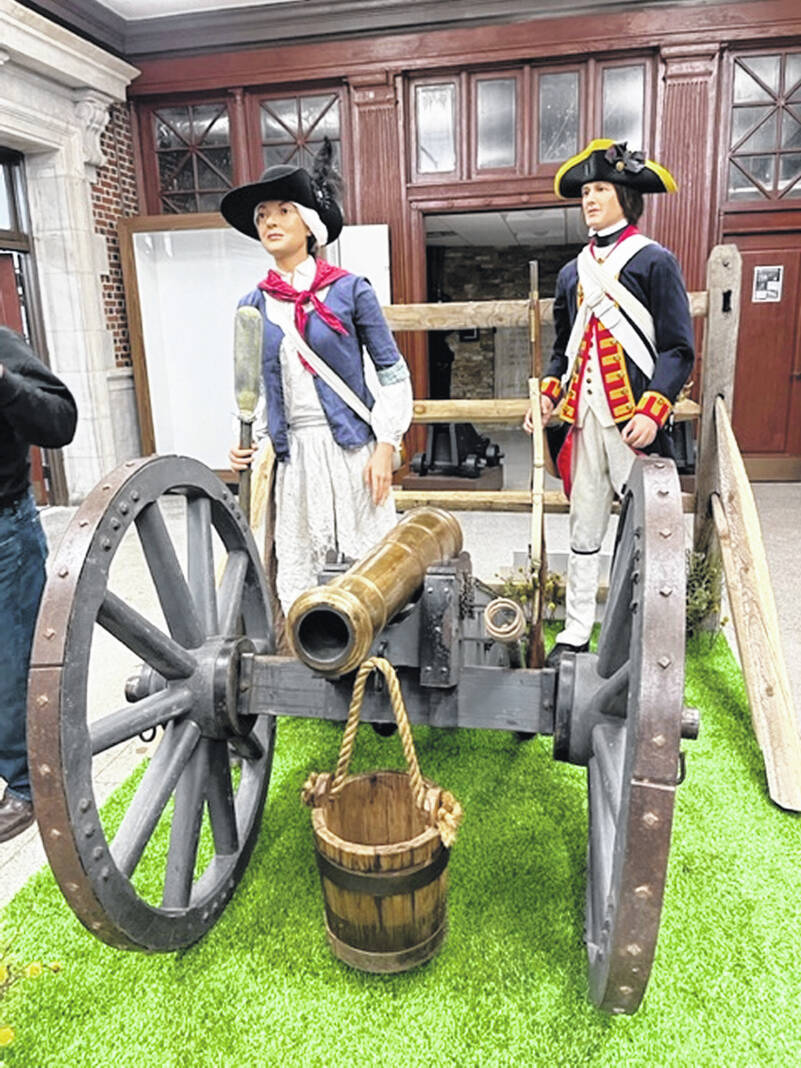
The cannon rests in the unit’s Drexel Armory which houses the Drexel University’s ROTC Unit. The exhibit in the lobby of the armory depicts Molly Pitcher and a 4th Continental Artillery man behind the 3-pound cannon.
Submitted photo
GREENVILLE — In 1791 William Ferguson, an artillery officer of the 1st American Regiment (1st AR), oversaw the building of Fort Jefferson. Two weeks later about 50 of the 1st AR artillery were killed at St. Clair’s Defeat on the Wabash where Fort Recovery would later be built. In 1793-1796 the remaining 1st AR soldiers would make up part of Anthony Wayne’s 1st Sub Legion at Greene Ville. Ferguson had fought in the Fourth Continental Artillery during the Revolutionary War. Their best-known action was at Monmouth where the wife of a wounded soldier helped fire a cannon when her husband went down. Her name was Mary Hays but was nicknamed Molly Pitcher. She is portrayed in the cannon picture in uniform.
In 1970, students at Miami (Ohio) University formed a group called the 9th Virginia Regiment, and recreated part of George Washington’s Continental Army that fought from Fort Pitt into Ohio against British and Native Americans. They reenacted the 9th Va. as the Official Bicentennial Regiment for the State of Ohio. Virginia had claimed the Ohio Country during the Revolutionary War. Hence the Ohio Bicentennial Commission bought a three-pounder cannon made at Adirondack Forge in 1976 and gave it to the 9th Virginia Regiment. During the Revolutionary War Bicentennial, they performed with two groups from the East as the Corps of the Continental Line. Each of these three regiments had a 3-pound grasshopper cannon. It was quite a site to see 225 soldiers with a full camp and three cannons.
In 1985, the 9th Virginia became the First American Regiment. Since then, the 1st AR has been performing at Ohio Indian War sites depicting the U.S. Army. Members of both the recreated 9th Va. and the 1st AR were from the Cincinnati/Springfield/Dayton area, although many traveled from the rest of Ohio and neighboring states.
After 53 years of living history performances, the 9th Virginia/1st American Regiment is selling their camp equipment and 3 pound “grasshopper” style cannon. The cannon is so named because it fired a 3-pound shot and could be carried by eight soldiers using poles sticking out that makes it look like a giant grasshopper. The early army liked this kind of cannon on the 1790’s frontier because it could be carried brief distances over obstacles in rough terrain.
In 2022, the 103rd Engineering Battalion of the Pennsylvania National Guard offered to buy the cannon. The cannon was first offered to the “Friends of Fort Jefferson” (FOFJ) to be placed in a future Visitor Center at Fort Jefferson. The FOFJ were not in position to accept the cannon at that time, so the officers of the 1st AR sold the cannon to the Pennsylvania National Guard. They received a $12,000 check which was then donated to the FOFJ. It is to be used for the preservation, protection and interpretation of the 17-acre farm recently purchased by FOFJ, which is adjacent to the south border of Fort Jefferson Memorial Park.
The lineage of the 103rd Engineering Battalion who bought the cannon goes back to the Fourth Continental Artillery from Philadelphia. Now, the 3-pounder rests in the unit’s Drexel Armory which houses the Drexel University’s ROTC Unit. The exhibit in the lobby of the armory depicts Molly Pitcher and a 4th Continental Artillery man behind the 3-pound cannon. After 47 years of service representing Ohio, the cannon honorably rests in the Philadelphia Armory lobby and can be seen by students, soldiers and visitors passing through the area.
The 9th/1stAR organization wholeheartedly supports the protection, preservation, and interpretation of the 17-acre battlefield and campsite of Fort Jefferson.
The Friends of Fort Jefferson cannot thank the 9th Va./1st AR enough for their support. They have a long way to go and have a lot of stories to tell along the way. Their primary goal is to retire the 17-acre loan made to purchase this part of the Fort Jefferson battlefield and turn that property over to the Darke County Park District to preserve it for the general welfare of the people. FOFJ hopes to use Fort Jefferson as “Common Ground” and tell the correct history of how North America was opened for settlement at the expense of the Native Americans.




